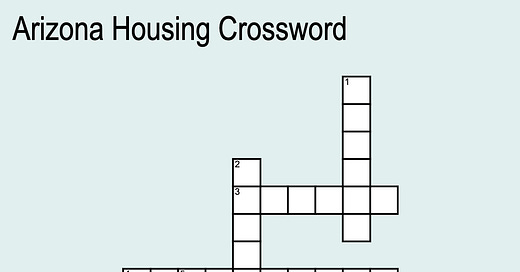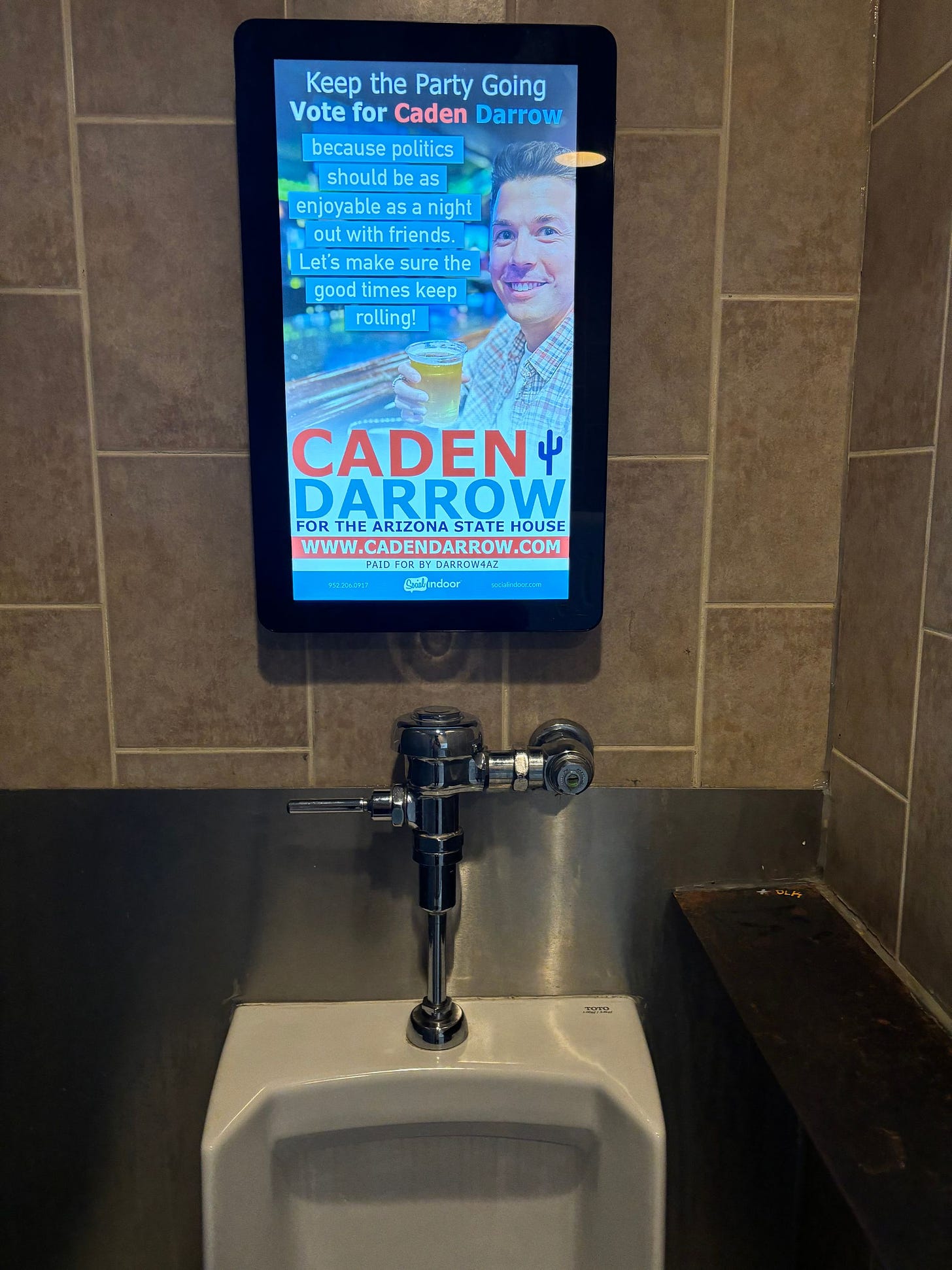The builders’ take on housing bills
Legislation only works with compliance ... Just show them more evidence ... And let's party.
Arizonans often point to a dire lack of affordable housing options when asked about their top concerns in the state.
And many politicians run on a platform that they’ll do something about it.
The truth is, housing reform is a painstakingly slow process where tangible change comes from many smaller turn-of-the-screw policy changes at every level of government.
This year, the Legislature passed at least four of those turn-of-screw bills. In essence, they force localities to adhere to a set of zoning changes in hopes of increasing housing stock.
HB2720: Municipalities with at least 75,000 people have to adopt codes allowing the use of accessory dwelling units, or casitas, on lots zoned for single-family use by Jan. 1, 2025.
HB2721: Municipalities with at least 75,000 people must allow for the development of duplexes, triplexes and other multi-family home options on lots zoned for single-family use by Jan. 1, 2026.
HB2297: Municipalities with at least 150,000 people have to allow multifamily residential development on up to 10% of commercial, office or mixed-use buildings by Jan. 1, 2025. The law also includes language to speed up the zoning process.
SB1162: Municipalities have to install zoning code changes that speed up the approval process for construction. The localities also have to publish a housing needs assessment every five years, starting Jan. 1, 2025, that outlines the total need for additional housing through population and job growth data and how much of a locality’s land is zoned for housing.
Former Sen. Steve Kaiser championed similar housing legislation in 2023 that was killed amid opposition from cities and towns. But Tuesday, he held a panel discussing some of the bills he helped pass in his new life as a lobbyist.
Much of the focus on the housing bills has been some cities’ resistance to them. But what do the developers who go through the cumbersome zoning processes think?
Joe Meyer, who heads a multifamily development company, compared the zoning process to walking through a “labyrinth of decision makers.” Some city officials favor commercial development over housing, and they use barriers built into zoning laws to influence what gets approved.
“The one thing that hasn't changed, first and foremost, is that people just don't like to have apartments built,” Meyer said.
The panelists explained how heightened neighborhood opposition can bring the process to a halt. But HB2297 requires cities to allow commercial space to be redeveloped into housing without a public hearing.
“Literally, you can bring you know, crematoriums next to neighborhoods, and they're happier (than bringing apartments),” zoning attorney Jason Morris said.
But the need for housing is more important than ever, the panelists explained.
Mark McFate, a vice president with CBRE Phoenix Multifamily Institutional Properties, said the supply of apartments in Phoenix is way below demand, and while there are “waves” in the availability of housing, “we can see we're going to go into an undersupply again.” But legislation that speeds up the zoning process “helps create a degree of certainty” that can help add housing stock, he said. SB1162 requires cities to give zoning applications the ok, or not, within 30 days.
The bills will quicken the decision on initial approval, but there’s still a mess of site plan, water, traffic and other approval processes to get through, Morris explained.
And while the laws are intended to preempt local zoning rules, Morris said it's still up to the cities to make it work.
Some cities are focusing on a phrase in the bill that says municipalities have to allow residential development on “not more than” 10% of existing commercial buildings, and taking advantage of that language to designate only 2% of commercial space to housing, which is a valid legal interpretation, but not the intention of the bill.
“You've got a bill that is a great tool if cities want to use it as a great tool, economic development wise, planning wise,” Morris said. “If there is buy-in, it's wonderful. If there is resistance, nothing is going to change.”
We know you readers love crosswords. So we made you an Arizona Housing policy crossword. Send screenshots of your finished crossword to info@arizonaagenda.com and we’ll give you a shout-out later this week.
Click here to test your Arizona housing literacy.
That’ll work: Surveillance cameras, GPS tracking and see-through walls are all part of election officials’ efforts to stop election skepticism with “radical transparency” in how they do their jobs, the Washington Post’s Yvonne Wingett Sanchez reports from Pinal County, where local Supervisor Kevin Cavanaugh still doesn’t believe the results of the primary election race he lost for sheriff. The county has ordered a third-party investigation into its election to quell his concerns.
Demotion for show: Although Gov. Katie Hobbs ostensibly demoted three of her department heads after acknowledging they couldn’t win confirmation from Senate Republicans, she didn’t cut their pay, Capitol Media Services’ Bob Christie reports. Department of Child Safety former director David Lujan, Department of Environmental Quality former director Karen Peters and Department of Veteran Services former director Dana Allmond all have significantly reduced duties, but are still earning $220,000, $224,000 and $170,000 respectively.
Filling big shoes: Tolleson school board member and Democratic state Rep. Elda Luna-Nájera was having a consensual but totally inappropriate relationship with Tolleson Unified School District Superintendent Jeremy Calles, an investigation found after he filed a sexual harassment complaint against her, per the Republic’s Madeleine Parrish. Luna-Nájera was appointed to the Legislature to replace disgraced former Democratic Rep. Leezah Sun.
Don’t vote mad: As activists target all sorts of judges on this year’s ballot — including most notably state Supreme Court Justices Clint Bolick and Kathryn King over their votes to uphold the state’s near-total abortion ban — a campaign to protect judges has sprung up, the Capitol Times Kiera Riley writes. Arizonans for an Independent Judiciary is urging voters to retain all judges.
“Our position is ‘the system works,’” Timothy Berg, co-chair of the PAC, told Riley. “We’ve got good people. The judicial performance review process works, and you ought to rely on that and information like that, rather than just somebody getting mad at the judge over one case or two cases.”
Not retaining himself: Arizona Supreme Court Justice Robert Brutinel, who has been on the state’s top bench since 2010, is calling it quits as of Halloween, he told Hobbs in a letter. Arizona forces its Supreme Court justices to retire at 70, but he’s still a few years out, the Republic’s Stacey Barchenger reports.
Help us retain these jobs by upgrading to a paid subscription today.
So much border, so little time: Vice President Kamala Harris’ swing through Arizona this Friday will include the inevitable border photo op, Scripps News reports, noting that polling shows voters trust Donald Trump more to solve the issue.
Roadkill reborn: In KJZZ’s latest edition of dead animals and the tribes that use them, we learn that the state has a “roadkill repository” where animals like desert tortoises are scooped up and stored for ceremonial use by tribal members.
“Without the repository, they would go in the dumpster. Then what?” Arizona Game and Fish Department tribal liaison Jon Cooley told KJZZ’s Gabriel Pietrorazio. “So there’s a missed opportunity, knowing that there’s a culture out there that really has [a] high interest in doing something productive with that wildlife.”
Hank was using the urinal at an Arcadia bar recently when Legislative District 8 Republican House candidate Caden Darrow suddenly got all up in his face, wanting to party and asking for our vote.
It was unnerving.











This housing issue is bothersome. It is real, but with all the apartment complexes going up at least in and/or near downtown Phoenix, I have yet to see one that is affordable to the people who truly need housing. (While I own a house, my house payments are about 1/3 of the rent being asked for less square footage.) When was the last one built that took Section 8 vouchers? How many "luxury" complexes are necessary to "meet" this suggested need? How many are fully occupied or owned by investors who use them for short term rentals? I find it difficult to get a straight answer.
I'm surprised that you have so firmly jumped on the platform that "its all the cities and towns fault" to the affordable housing crisis. The recent legislation, both proposed and passed, has done nothing to promote affordability, they are simply ways to bypass the public comment portion of rezoning a parcel. Are you suggesting that the public should not have any say in what is developed in their communities? I've never gotten that "vibe" from you guys here on the Agenda. I'm a supporter of the open and free market but where does the public come in? Local elected officials are shouldering the burden, public pressure and honestly the brunt of the public outrage over the number of rental units being constructed while the multi-family owners are reaping the rewards of unfettered "market-driven" rental rates. No one wants rent control but we cannot rent our way out the housing market and cities and town are not the bad guys here.